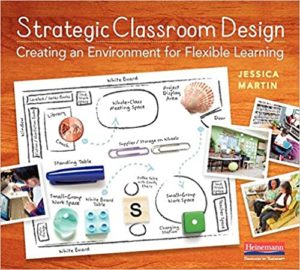Designing Classrooms for Flexible Learning
Strategic Classroom Design: Creating an Environment for Flexible Learning
By Jessica Martin
(Heinemann, 2020 – Learn more)

In the midst of the COVID-19 pandemic and remote teaching, the importance of physical space has never been so clear. As I struggle to find appropriate spaces within my home to conduct Zoom meetings and film instructional videos, I imagine how much my students must be affected by the loss of a physical classroom.

Although no teacher aims for such a classroom, the limitations of funding, square footage, and time can make forming an effective learning space a daunting task.
Jessica Martin’s Strategic Classroom Design is both a call and guide to improve physical spaces in learning environments. Martin urges educators to leave behind the assumptions and rigid way we think a classroom should look in favor of what really helps students learn. Through real accounts of educators attempting alternate designs and student experiences, a base in psychology, and an array of suggestions, this book reads like an inspirational toolbox.
Content
The first four chapters each include the following elements and structure. An anecdote from a teacher or student presents a narrative that firmly sets the topic at hand into a familiar situation. The bulk of the chapter is a plan directing the reader on how they might apply the topic in their own classroom. Martin takes care to balance her instructions with enough specificity to be immediately practical and have enough adaptability to fit into any classroom.
Interspersed among the plans are sections of “Considerations” — thoughtful discussions of how your unique teaching situation can and should impact your design choices. Numerous pictures of real classrooms give life to Martin’s descriptions and serve as an expertly created vision board.
The chapters end with a sample lesson plan, written in the style of Calkins’ Teachers College Reading and Writing Project (2003), which provides a way to introduce new spaces and uses to students. Rounding out the chapters are “If-Then Scenarios” sections, which directly address the potential complications, and further questions that could easily arise trying to implement these ideas.
The chapters cover the following pathway through a classroom revitalization process:
1. Creating a Physical Environment That Empowers Learners
Chapter 1 begins the plan where the process begins, with the initial layout. Martin outlines ways to refigure available space into more flexible, varied, and functional uses. Her specific discussion of tables and desks, windows, corners, walls, and more brings the conceptual down to the right-now, in-your-own-classroom, sliding-over-cabinets-as-you-read level. The lesson plan outlines how to introduce new students to unfamiliar spaces and set the tone of expectations for the whole year.
2. Making Sure Every Classroom Space Enhances Teaching and Learning
Chapter 2 delves into the specialized work spaces: “the library, multimedia learning space, makerspace, play area, content area, and art space” (Martin xxvi) that transform every part of the room into a learning aid. Martin lists all the tools and objects needed to create these spaces, including a chart of tech tools and their potential in the classroom. The lesson plans introduce students to the classroom library and to a math area.
3. Navigating the Classroom with Flexibility and Ownership
Chapter 3 moves into design that works with student movement and individuality. Martin emphasizes teaching space interaction as a first answer to the essential question, “how do we prepare our students to access supplies and materials, so they can focus on the bigger tasks at hand and move with purpose?” (Martin 79).
The chapter also highlights co-authoring agreements with students on how movement will occur in the classroom, so that the plans truly work for your specific class. The lesson plan teaches “smooth moves” and prepares students for greater physical autonomy in the classroom.
4. Considering the Social-Emotional Needs of Students in a Classroom Environment
Chapter 4 addresses the psychology of physical environments and how to maximize impactful elements on a budget. Top considerations include comfort, cleanliness, color, and light. The chapter suggests flexible seating, shoeless learning, plants, and music for comfort and cleanliness.
Natural light and open windows are linked to rational decision making, and a careful look at color theory can transform the impact of a room on students. Attention to noise and sound in the classroom are similarly important. The lesson plan teaches students to select a work space that will be productive for them, based on their own social-emotional introspection.
5. One Teacher’s Journey with Strategic Classroom Design
Chapter 5 tells the story of a teacher, Jamaica, as she embarks on the process of reimagining her classroom design. Martin takes the reader step by step through Jamaica’s goals, administrative support, design choices, and results. Before, after, and “with student” images show just how real and transformative this process can be.
Concluding Thoughts
While this book definitely makes allowance and note of the complexities of every given class of students, it left me wanting more information about how these design principles affect more than the mainstream student. Every class will have students with exceptional needs, and any thoughtful classroom design should consider these needs beyond what works for the majority.
Martin does mention making enough space to maneuver a wheelchair and most of her suggestions would be beneficial to all students alike, but I would have liked to read more on what specific choices could impact specific student needs. Nonetheless, no book can account for all complexities, and Martin certainly urges educators to think deeply about what their individual students need.
It would be difficult to read Martin’s Strategic Classroom Design and not leave convinced that intentional spaces are a vital need of every classroom. Beyond merely inspiring her readers, Martin takes on a practical partnership with the reader with ready-to-use plans for action.
As Martin reminds us, “it doesn’t have to be all-or-nothing” (Martin 133), but I hope any educator with a classroom would read this book and consider taking that first step toward creating a better learning environment.
Eileen Hornbostel is a student at Pepperdine University and a pre-service teacher in Malibu, California.




































